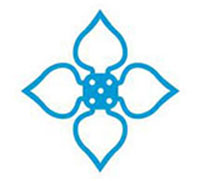Translated Kimono exam practice questions
Curious how the written part of the kimono exam looks like ?
(my attempt of translating public kimono exam questions)
See the Media page section Exam books for the mock exam book and various study books.
Do you like the short answers or the long answers, feel free to mail me.

Here are some level 5 questions (beginner)
Found on the Kimono taizen site
1) 着物の衿の合わせ方は、洋服同様に男女で異なる。
The method of aligning the kimono collar is different for man and woman.
True False
2) 紋付羽織袴以外にも男性には正装と呼ばれる服装がある。
A man has besides the 'crested kimono with haori and hakama' dress also another 'formal attire'.
True False
3) 衣替えの習慣は絶対に守らなくてはならない。
The custom of seasonal change of clothes must be unconditionally obeyed.
True False
4) 足袋のサイズを測るのに用いられる昔からの単位は何か。
What is the unit from the old days when it is used to measure size of tabi?
尺 (shaku)
寸 (sun)
文 (mon)
センチ (centimeter)
5) 色足袋や柄足袋は女性用の足袋で、本来は男性用ではない。
Colored tabi and tabi with pictures that are used by women were originally not used by men.
True False
6) 着物に流行がないというのは本当のことである。
It's a true thing that there is no fashion in a kimono.
True False
7) 着物は直線裁断で加工されるが、足袋は立体裁断によって製造される。
Although kimono is processed in a straight line cut, tabi socks are made by draping.
True False
8) 「着流し」についての説明で最も正確なものはどれか。
Which in most accurate a description of 'Kinagashi'
広くは袴を着けない着方をいう (universally the case when one does not wear a hakama)
長着と帯だけで羽織も袴も着けていない場合をいう (The situation where only a kimono and obi is worn and not a haori and hakama)
兵児帯を用いて長着を着る場合をいう (when a hekoobi is worn together with a kimono)
羽織を着ていない場合を常にそういう (always the case when a haori is not worn)
9) 大島紬で有名な奄美大島は何県にあるか。
In which prefecture lies Amami Ōshima, famous for Oshima pongee?
沖縄県 (Okinawa prefecture)
熊本県 (Kumamoto prefecture)
鹿児島県 (Kagoshima prefecture)
宮崎県 (Miyazaki prefecture)
10) 「襦袢」の読み方で正しいものはどれか。
What is the correct way to read/spell 'undershirt' ?
じはん (jihan)
じばん (jiban)
じゅぼん (juhon)
じゅばん (juban)
Answer sheet Kimono taizen site practice questions
1. False
The aligning of the kimono collar is the same for men and women. Left over right.
2. True
Besides the 紋付羽織袴 (crested kimono with haori and hakama) is the 喪服 (-mofuku-, kimono for mourning)
3. False
Please wear a kimono as you like, it is great if a daily wearer can put together an outfit following all the seasons rules, but very few will look at you funny if you can’t as it’s hard and can be expensive to collect all the proper pieces.
In the tea ceremony world however the following of the seasons is among the strictest.
4. Mon
Mon is the old measurement for shoe sizes (2.4 cm). Shaku = 30.3 cm, Sun = 3.03 cm
5. False
Edo era (1596-1868)
Coloured or patterned tabi were to be worn by performers and entertainers.
Samurai were permitted to wear any colour except gold thread or purple.
Commoners were permitted to wear the traditional indigo blue colour.
Tabi - unique Japanese socks
6. False
Edo era (1596-1868)
There were even fashion contests between the wives of the wealthiest merchants, who tried to
outdo one another with ever more dazzling displays of splendid costume.
History of the Kimono
7. True
8. The situation where only a kimono and obi is worn and not a haori and hakama
Kingashi = dressing casually
9. Kagoshima Prefecture
About Amami Ōshima island
About Oshima tsumugi pongee
10. じゅばん (juban)
Juban (an underwear worn with kimono)
1. False
The aligning of the kimono collar is the same for men and women. Left over right.
2. True
Besides the 紋付羽織袴 (crested kimono with haori and hakama) is the 喪服 (-mofuku-, kimono for mourning)
3. False
Please wear a kimono as you like, it is great if a daily wearer can put together an outfit following all the seasons rules, but very few will look at you funny if you can’t as it’s hard and can be expensive to collect all the proper pieces.
In the tea ceremony world however the following of the seasons is among the strictest.
4. Mon
Mon is the old measurement for shoe sizes (2.4 cm). Shaku = 30.3 cm, Sun = 3.03 cm
5. False
Edo era (1596-1868)
Coloured or patterned tabi were to be worn by performers and entertainers.
Samurai were permitted to wear any colour except gold thread or purple.
Commoners were permitted to wear the traditional indigo blue colour.
Tabi - unique Japanese socks
6. False
Edo era (1596-1868)
There were even fashion contests between the wives of the wealthiest merchants, who tried to
outdo one another with ever more dazzling displays of splendid costume.
History of the Kimono
7. True
8. The situation where only a kimono and obi is worn and not a haori and hakama
Kingashi = dressing casually
9. Kagoshima Prefecture
About Amami Ōshima island
About Oshima tsumugi pongee
10. じゅばん (juban)
Juban (an underwear worn with kimono)
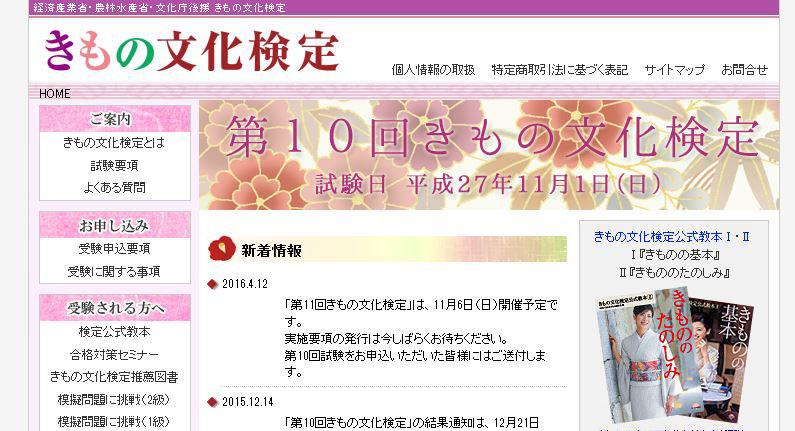
Here are some level 5/4 example questions
Found on the Kimono kantei site
[01] 既婚女性の礼装として最も正式なきものを次の中から選びなさい。
Choose the most formal kimono from among the following as a dress of married women.
(1) 小紋 (komon)
(2) 御召 (omeshi)
(3) 紬 (tsumugi)
(4) 黒留袖 (kuro tomesode)
[02] 男性きものについて、長着と帯だけの着方を何と呼びますか、次の中から選びなさい。
About the men's kimono, how is it called when wearing only a kimono and obi, choose from among the following.
(1) しゃれ着 (Sharegi)
(2) 紋付羽織袴 (Montsuki haorihakama)
(3) 着流し (Kinagashi)
(4) 準礼装 (Junreisou)
[03] 次の中から沖縄で生産される後染めの染織品を選びなさい。
Choose from the following the textile produced in Okinawa that is dyed after weaving.
(1) 琉球紅型 (Ryukyu Bingata)
(2) 芭蕉布 (Bashōfu)
(3) 八重山上布 (Yaeyama Jōfu)
(4) 読谷山花織 (Yomitanzan Hana Ori)
[04] 平安時代に下着であったものが、鎌倉時代以降に外衣となり、桃山時代には一般的な衣服として定着したのが現在のきものの原型と言われていますがそれを次の中から選びなさい。
Which underwear in the Heian period becomes the protoype of the modern day kimono .... (very loosly translated)
(1)狩衣 (kariginu or karigoromo)
(2)小袖 (kosode)
(3)小袿 (ko-uchigi)
(4)直衣 (naoshi)
[05] 次の中から夏の装いとしてふさわしくないきものはどれか、次の中から選びなさい。
Which next kimono is not suitable as a guise of summer, Choose from among the following.
(1) 紗 (sha)
(2) 絽 (ro)
(3) ゆかた (yakata)
(4) 袷 (awase)
[06] 紋について、次の中から正しい読み方ものを選びなさい
Concering the crest, choose the kanji with the correct reading from the ones below.
(1) 日向紋(ひゅうがもん) (hyuu ga mon)
(2) 陰紋(いんもん) (in mon)
(3) 菅繍陰紋(かんしゅうかげもん) (kan shuu kage mon)
(4) 中陰紋(ちゅうかげもん) (chuu kage mon)
[07] 帯を結ぶときにお太鼓部分の形を整えて、締める道具を次の中から選びなさい
During the tying of the obi creating the otaiko (drum) shape, which tool is used to fasten
(1) 帯板 (obi ita)
(2) 帯枕 (obi makura)
(3) 腰紐 (koshi himo)
(4) 帯揚げ (obi age)
[08] 「紬」の説明について適当なものを次の中から選びなさい
[tsumugi] Explain about the proper object, please choose one of the below
(1) 繰り返し模様を染めたきもの (Kimono dyed with a repetitive pattern)
(2) 黒以外の色で一色染にした無地のきもの (Kimono dyed with a solid color other than black)
(3) 真綿から紡いだ糸で織られたきも (Kimono which is woven with a thread spun from silk floss.)
(4) 生地の表面にシボがある先染めの絹のきもの (Dyed silk kimono and on the surface there is a texture).
[09] 女性の装いで、室内で着ていてもよいとされるのは次のどれですか。
About womens clothing, which of the following is fine to be worn indoor.
(1) 道中着 (douchuugi)
(2) 雨コート (ame coat)
(3) 羽織 (haori)
(4) 道行コート (michiyuki coat)
[10] 初めて本裁ちきものを着るのはどれか、次の中から選びなさい。
The first time wearing a kimono cut with the 'hondachi' technique is which one, choose an answer from below
(1) 成人式 (seijin no hi)
(2) 宮参り (miyamairi)
(3) 七五三 (shichi-go-san)
(4) 十三参り (juusan mairi)
[11] 子供用のきもので、身長に合った着丈にする縫い方を何といいますか、次のから選びなさい。
Kimono used by children, what do you call the sewing method to adjust the length of the kimono to match the height of the child, choose from the following.
(1) つい丈 (tsui take)
(2) 肩あげ (kata age)
(3) 腰上げ (nishi age)
(4) 被布 (hifu)
[12] 染色の際に、隣り合う色が混ざらないように、糊を用いて防染をして染める方法で、江戸時代に考案された染色技法は何ですか。次の中から選びなさい。
What is the dyeing technique invented in the Edo period with the help of a paste to prevent the color next to each doesn't mix when dying, choose from the next.
(1) 辻が花染 (tsujigahana zome)
(2) 紅花染 (benibana zome)
(3) 友禅染 (yuuzen zome)
(4) 鹿の子絞 (janonishibari)
[13] 三巻きして「貝の口」や「片ばさみ」結びをする男性用の帯は次の内どれか選びなさい。
How is the obi for men with three windings and [Kai no Kuchi] or [Kata Basami] knot called, please choose the correct one below.
(1) 半幅帯 (Hanhaba obi)
(2) 角帯 (Kaku obi)
(3) 兵児帯 (Heko obi)
(4) 袋帯 (Fukuro obi)
[14] 子供の成長を祝って神社などにお参りする行事できものの上に被布を着せる一般的な年齢は次の内どれですか。
Out of the next choices, which is the general age where one puts on an overcoat (hifu) at an event praying at the Shinto shrine to celebrate the growth of the child.
(1) 三歳 3 years old
(2) 五歳 5 years old
(3) 七歳 7 years old
(4) 十三歳 13 years old
[15] 種類の違う色はどれですか、次の中から選びなさい。
Which one is a different kind of color, choose from below answers.
(1) 刈安色 (kariyasu iro)
(2) 黄蘗染色 (kihada senshoku)
(3) 木賊色 (tokusa iro)
(4) 山吹色 (yamabuki iro)
[16] 糸を先に染めないで織り上げた織物は、次のうちどれか。選びなさい。
Which textile is finished by weaving without dyeing the thread first, choose from the next answers.
(1) 絣 (Kasuri)
(2) 大島紬 (Ooshima tsumugi)
(3) 縮緬 (Chirimen)
(4) 御召 (Omeshi)
[17] 振袖にふさわしい帯は次のうちどれか、次の中から選びなさい。
Which is the appropriate obi for the long-sleeved kimono (furisode), choose from the answers below.
(1) なごや帯 (nagoya obi)
(2) 袋帯 (fukuro obi)
(3) 半幅帯 (hanhaba obi)
(4) 博多帯 (hakata obi)
[18] 半襟を付けて着用するものを次の中から選びなさい。
Choose the item which to attach a decorative collar (han-eri) to.
(1) 肌襦袢 (hada juban)
(2) 長襦袢 (naga juban)
(3) ゆかた (yukata)
(4) 小紋のきもの (komon kimono)
[19] 第一礼装にふさわしくないのはどれか、次の中から選びなさい。
Which is not suitable as a foremost formal dress, choose from the options below.
(1) 五つ紋の黒羽二重のきものと仙台平の袴 (itsutsumon no kuro habutai no kimono to sendaihira no hakama)
(2) 振袖 (furisode)
(3) 訪問着 (houmongi)
(4) 喪服 (mofuku)
[20] 献上柄とよばれる特徴ある柄の織物は、どれか次の中から選びなさい。
???
(1) 西陣織 (nishijin ori)
(2) 博多織 (hakata ori)
(3) 首里織 (shuri ori)
(4) ミンサー織 (minsaa ori)
[21] 銘仙絣模様といわれる柄が作られた時代はいか、次の中から選びなさい。
In which era was the Meisen Silk dye pattern created.
(1) 明治時代 (Meiji era)
(2) 大正時代 (Taisho era)
(3) 江戸時代 (Edo era)
(4) 昭和時代 (Showa era)
[22] 次の模様の中からの仲間でないのはどれか、次の中から選びなさい。
Which of the following does not belong in this list of patterns
(1) 貝桶 (kaioke)
(2) 扇面 (senmen)
(3) 雪輪 (yukiwa)
(4) 薬玉 (kusudama)
[23] きものを収納するとき間違っているのはどれか、次の中から選びなさい。
Choose from the following choices the incorrect way to put away a kimono
(1) 絹物とウールものは別々に収納する (Kinumono to ūru mono wa betsubetsu ni shūnō suru)
(2) 防虫剤の樟脳とナフタリンは一緒に使うと効き目が強くきものの保管によい (Bōchūzai no shōnō to nafutarin wa issho ni tsukau to kikime ga tsuyoku kimono no hokan ni yoi)
(3) 機密性の高いプラスチックの収納箱は避ける (Kimitsu-sei no takai purasuchikku no shūnōbako wa yokeru)
(4) きものを使用した後は陰干しなどして湿気を飛ばす (Kimono o shiyō shita nochi wa kageboshi nado shite shikke o tobasu)
[24] 式典や半喪に着用できるきものは次のうちどれか、選びなさい。
Choose which kimono can be used for a ceremony and semi-mourning.
(1) 付け下げ (tsukesage)
(2) 小紋 (komon)
(3) 色無地 (iromuji)
(4) 紬 (tsumugi)
[25] 新潟県で作られていない染織品はどれですか、次の中から選びなさい。
Choose from the next answers which dyeing and weaving product is not made in Niigata.
(1) 越後上布 (echigo joufu)
(2) 塩沢紬 (shiozawa tsumugi)
(3) 十日町紬 (tokamacgi tsumugi)
(4) 宮古上布 (miyako joufu)
Answer sheet Kimono kantei site pactice questions with visual aid
[01] Choose the most formal kimono from among the following as a dress of married women.
[01] Answer = (4) Kuro Tomesode
[02] About the men's kimono, how is it called when wearing only a kimono and obi, choose from among the following.
[02] Answer = (3) Kinagashi
[03] [not translated yet]
[03] Answer = (1) Ryukyu Bingata
[04] Which underwear in the Heian period becomes the protoype of the modern day kimono .... (very loosly translated)
[04] Answer = (2)
[05] Which next kimono is not suitable as a guise of summer, Choose from among the following.
[05] Answer = (4) awase
[06] Concering the crest, choose the kanji with the correct reading from the ones below.
[06] Answer = (4)
[07] During the tying of the obi creating the otaiko (drum) shape, which tool is used to fasten
[07] Answer = (2) Obi makura
[08] [tsumugi] Explain about the proper object, please choose one of the below
[08] Answer = (3)
[09] About womens clothing, which of the following is fine to be worn indoor.
[09] Answer = (3)
[10] The first time wearing a kimono cut with the 'hondachi' technique is which one, choose an answer from below
[10] Answer = (4) Shrine visit by children of 13 years old
[11] Kimono used by children, what do you call the sewing method to adjust the length of the kimono to match the height of the child, choose from the following.
[11] Answer = (3) 腰上げ (koshi age)
[12] What is the dyeing technique invented in the Edo period with the help of a paste to prevent the color next to each doesn't mix when dying, choose from the next.
[12] Answer = (3) 友禅染 (yuuzen zome)
[13] How is the obi for men with three windings and [Kai no Kuchi] or [Kata Basami] knot called
[13] Answer = (2) Kaku obi
[14] Out of the next choices, which is the general age where one puts on an overcoat (hifu) at an event praying at the Shinto shrine to celebrate the growth of the child.
[14] Answer = (1) 3 years old
[15] Which one is a different kind of color, choose from below answers.
[15] Answer = (3)
[16] Which textile is finished by weaving without dyeing the thread first, choose from the next answers.
[16] Answer = (3) Chirimen
[17] Which is the appropriate obi for the long-sleeved kimono (furisode), choose from the answers below.
[17] Answer = (2) 袋帯 (fukuro obi)
[18] Choose the item which to attach a decorative collar (han-eri) to.
[18] Answer = (2) 長襦袢 (Nagajuban)
[19] Which is not suitable as a foremost formal dress, choose from the options below.
[19] Answer = (3) 訪問着 (houmongi)
[20] ??? The feature is called kenjo design fabric / The textile of the unusual pattern to be called a presentation pattern ???
[20] Answer = (2) 博多織 (hakata ori)
[21] In which era was the Meisen Silk dye pattern created.
[21] Answer = (2) 大正時代 (Taisho era)
[22] Which of the following does not belong in this list of patterns.
[22] Answer = (3) 雪輪 (yukiwa)
[23] Choose from the following choices the incorrect way to put away a kimono
[23] Answer = (2)
[24] Choose which kimono can be used for a ceremony and semi-mourning.
[24] Answer = (3) 色無地 (iromuji)
[25] Choose from the next answers which dyeing and weaving product is not made in Niigata.
[25] Answer = (4) 宮古上布 (miyako joufu)
[01] Choose the most formal kimono from among the following as a dress of married women.
 |
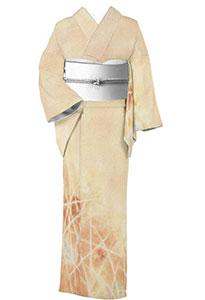 |
 |
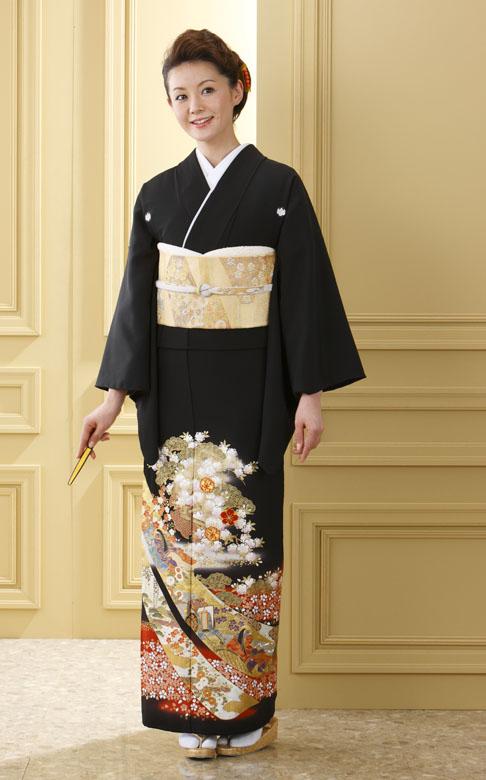 |
| (1) 小紋 (komon) Komon is a small patterned kimono that is known as townwear or everyday kimono. (Men only wear edo-komon, a very small patterned print that becomes 'invisible' from a distance.) |
(2) 御召 (omeshi) Omeshi is a silk crepe kimono. "Omeshi" means a noble person puts on clothes and is the highest class kimono in the woven class. Generally all woven cloth is considered casual clothing but with the right design you can consider it semi-formal. |
(3) 紬 Tsumugi is a daily or working kimono that is woven by unevenly spun silk thread. It's popular as a daily wear or street cloth (townwear) now. |
(4) 黒留袖 Kuro-Tomesode is worn by only married women. It is the most formal kimono of married women. It has 5 family crest and only a design at the bottom. |
[02] About the men's kimono, how is it called when wearing only a kimono and obi, choose from among the following.
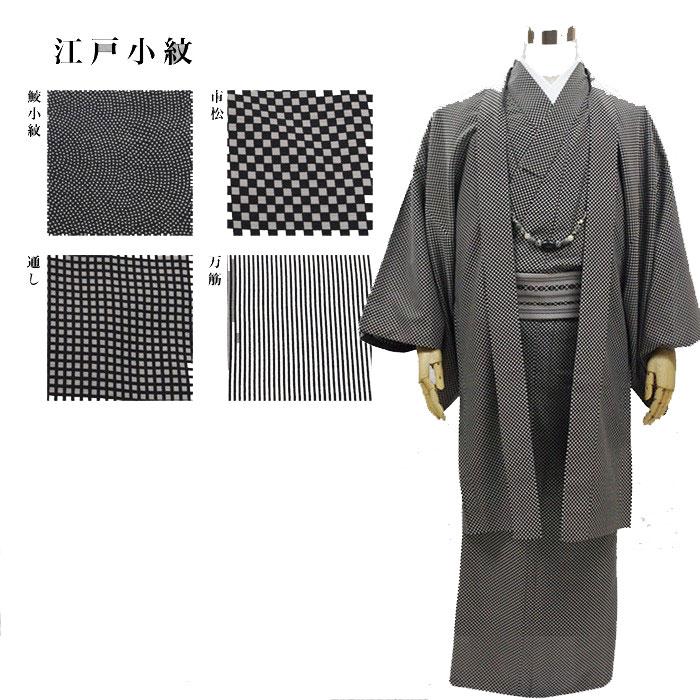 |
 |
 |
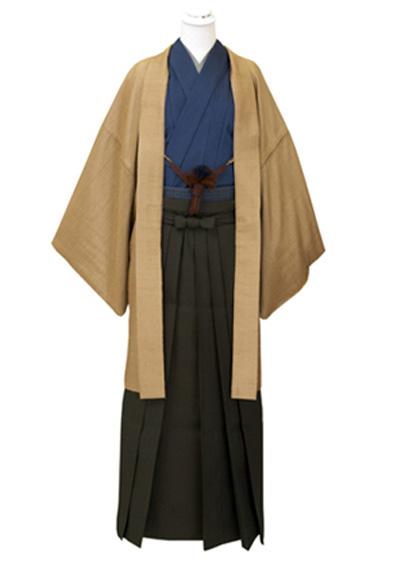 |
| (1) しゃれ着 / 洒落着(Sharegi) Stylish clothes: edo-komon kimono (no hakama and probably no crests) |
(2) 紋付羽織袴 (Montsuki haori hakama) Most formal kimono (besides the mofuku) with family crests. It's worn by men on formal parties or ceremonies, like marriage ceremonies of family or relative. |
(3) 着流し (Kinagashi) The casual kimono outfit when only a obi and kimono is worn made from:
|
(4) 準礼装 (Junreisou) A semi formal dress: Kimono+Haori+Hakama (no crest) |
[03] [not translated yet]
 |
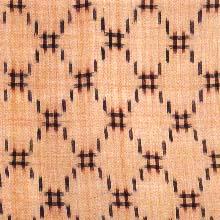 |
 |
 |
| (1) 琉球紅型 (Ryukyu Bingata) Ryukyu colorfully-dyed pattern produced in Naha City, Tamagusukumura, Okinawa. Dictionair: (Ryukyu Bingata |
(2) 芭蕉布 (Bashōfu) Cloth from the bashō or Japanese fibre banana as practised in Kijōka in Ogimi, Okinawa. Dictionair: Bashōfu |
(3) 八重山上布 (Yaeyama Jōfu) Eightfold summit cloth produced in Yaeyamagun, Okinawa. Dictionair: Yaeyama Jōfu |
(4) 読谷山花織 (Yomitanzan Hana Ori) Yomiyama flower weaving produced in Yomitanson Nakagamigun, Okinawa Dictionair: Yomitanzan Hana Ori |
[04] Which underwear in the Heian period becomes the protoype of the modern day kimono .... (very loosly translated)
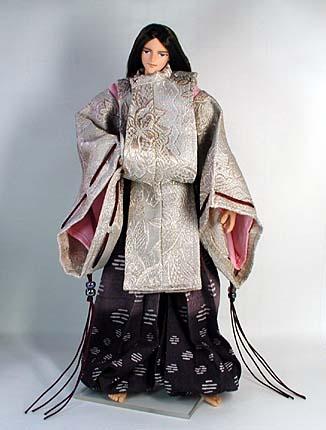 |
 |
 |
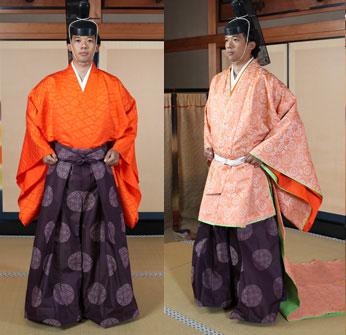 |
| (1) 狩衣 (kariginu or karigoromo) Informal clothes worn by the nobility from the Heian period onwards. |
(2) 小袖 (kosode) Kosode is a short sleeve clothing worn both as an undergarment and overgarment, it is what most people think of when using the much broader term kimono. The literal meaning of the term kosode is "small sleeve," which refers to the sleeve opening. Kosode evolved at some point in the late 14th century and replaced the many layered, unlined hirosodes. Over time kosode gradually developed into a wide variety of styles, with patterns and fabrics. |
(3) 小袿 (ko-uchigi) Heian period court clothing |
(4) 直衣 (naoshi) Everyday robes worn by males of the imperial family, nobility, etc from the Heian period onwards. |
[05] Which next kimono is not suitable as a guise of summer, Choose from among the following.
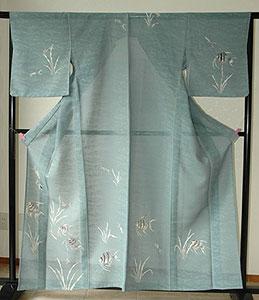 |
 |
 |
 |
| (1) 紗 (sha) (silk) gauze. |
(2) 絽 (ro) Silk gauze especially used in light clothing for high summer. Basically, ro and sha are all open “gauze” weaves |
(3) ゆかた (yakata) |
(4) 袷 (awase) Lined kimono, something you don't want to wear in the summer. |
[06] Concering the crest, choose the kanji with the correct reading from the ones below.
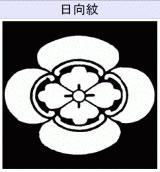 |
 |
 |
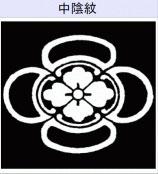 |
| (1) 日向紋(ひゅうがもん) The correct reading is Hinatamon Full white crest, most formal |
(2) 陰紋(いんもん) 陰 can be indeed be read as IN but the correct reading with mon is KAGE Outlined (shadow) crest, less formal. |
(3) 菅繍陰紋(かんしゅうかげもん) The correct reading is すがぬいかげもん (sugamei kagemon) embroided crest, least formal. |
(4) 中陰紋(ちゅうかげもん) Chuukagemon is indeed the correct reading Half shadow crest, formality between shadow and white crest |
[07] During the tying of the obi creating the otaiko (drum) shape, which tool is used to fasten
 |
 |
 |
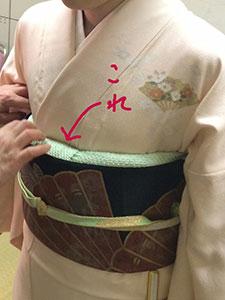 |
| (1) 帯板 (obi ita) Piece of stiff fabric worn under an obi at the front side to give it more shape.Nothing to do with shaping the drum. |
(2) 帯枕 (obi makura) Oval pad with two long strips tied underneath the obi to make it look fuller. |
(3) 腰紐 (koshi himo) Cord tied around the waist before an obi is tied. |
(4) 帯揚げ (obiage) Obi sash |
[08] [tsumugi] Explain about the proper object, please choose one of the below
 |
 |
 |
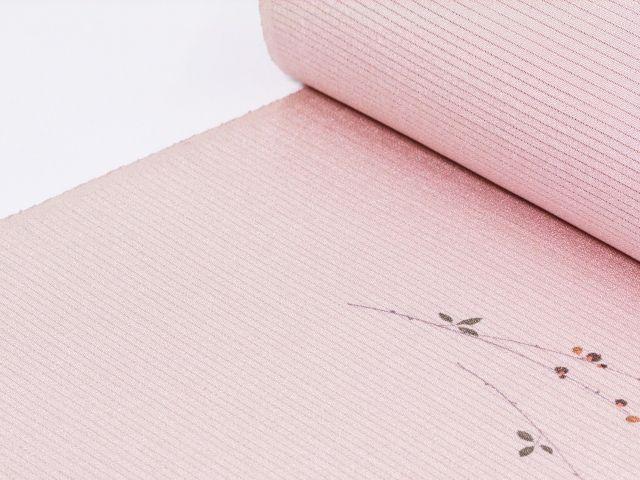 |
| (1) (Kimono dyed with a repetitive pattern). Does not explain the proper use of tsumugi. This explains about a komon. |
(2) (Kimono dyed with a solid color other than black) Does not explain the proper use of tsumugi. This explains about a iromuji. |
(3) (Kimono which is woven with a thread spun from raw silk) Tsumugi (pongee) is a soft thin cloth woven from raw silk. |
(4) (Silk kimono dyed and on the surface there is a texture). Does not explain the proper use of tsumugi. |
[09] About womens clothing, which of the following is fine to be worn indoor.
 |
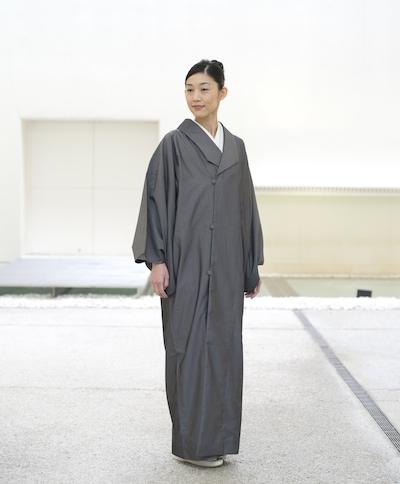 |
 |
 |
| (1) 道中着 (douchuugi) Along the way wear provides greater protection against inclement weather then the rain coat. Unlike the haori, it is good manners to leave take off this coat outside the front door and carrying it having folded it on one arm. |
(2) 雨コート (ame coat) Rain coat Provides complete cover of a kimono, shawls or stoles which serve the same purposes what a raincoat does in Western culture. |
(3) 羽織 (haori) Japanese formal coat traditional Japanese sort of hip- or thigh-length kimono-like jacket that can will not be closed by buttons or ropes but loosely stays together with a haori-himo. |
(4) 道行コート (michiyuki coat) Travelling coat Michiyuki are three-quarter length coats with square necklines. The most common materials for michiyuki are crepe fabric, silk and satin and often have no patterns, but can feature stripes, checks, or other designs that are more subtle than those of most kimonos and related garments. |
[10] The first time wearing a kimono cut with the 'hondachi' technique is which one, choose an answer from below
 |
 |
 |
 |
| (1) 成人式 (seijin no hi) Coming of age ceremony at the age of 20 held annually on the second Monday of January when a minor becomes an adult. |
(2) 宮参り (miyamairi) A traditional Shinto rite of passage in Japan for newborns. Approximately one month after birth (31 days for boys and 33 days for girls), parents and grandparents bring the child to a Shinto shrine, to express gratitude to the deities for the birth of a baby and have a shrine priest pray for his or her health and happiness. |
(3) 七五三 (shichi-go-san) A traditional rite of passage. In most regions around the country, boys and girls aged three, boys aged five and girls aged seven will be visiting a Shinto shrine with their parents. Held annually on November 15 to celebrate the growth and well-being of young children. As it is not a national holiday, it is generally observed on the nearest weekend. |
(4) 十三参り (juusan mairi) Shrine visit by children of 13 years old Since this is the first time i have heard about 'hondachi' and of a Shrine visit at 13 years of age, I can only say that this is the correct answer, not to why and how. |
[11] Kimono used by children, what do you call the sewing method to adjust the length of the kimono to match the height of the child, choose from the following.
 |
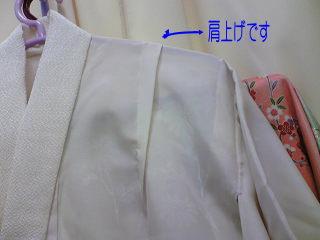 |
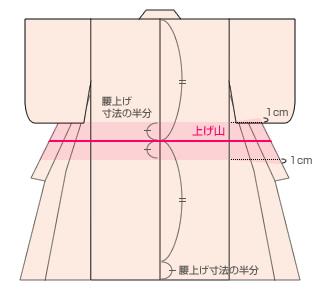 |
 |
| (1) つい丈 or 対丈 (tsuitake) Body length Making clothes by deciding the length of Mitake based on the length from the shoulder of the body to the leg ? |
(2) 肩あげ (kata age) Tuck at the shoulder of a child's clothes used to adjust the width of the sleeve section. |
(3) 腰上げ (koshi age) Tuck at the waist used to adjust the length of the kimono. |
(4) 被布 (hifu) Kimono jacket for 3 year old children |
[12] What is the dyeing technique invented in the Edo period with the help of a paste to prevent the color next to each doesn't mix when dying, choose from the next.
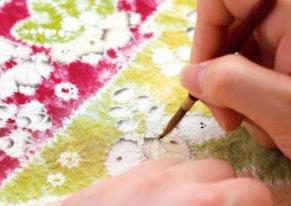 |
 |
 |
 |
| (1) 辻が花染 (tsujigahana some) Japanese fabric dyeing technique that originated in the Muromachi era. The extravagant patterns were rather more picturesque and it was more eye-catching than other ordinary kinds of Kimono.No paste is used to prevent colors next to each other mixing. |
(2) 紅花染 (benibana some) Safflower dyeing |
(3) 友禅染 (yuuzen zome) Silk printed by the Yuzen process Yuzen is a paste-resist method of dyeing. Other methods of resist dyeing are Rōketsuzome with wax, Katazome and Tsutsugaki with rice-paste |
(4) 鹿の子絞 (janonishibari) Clothed dyed in a dapple pattern |
[13] How is the obi for men with three windings and [Kai no Kuchi] or [Kata Basami] knot called
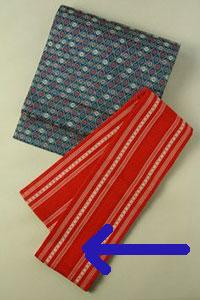 |
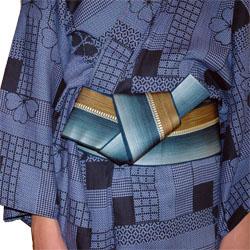 |
 |
 |
| (1) 半幅帯 (Hanhaba obi) is an 'Half width obi' worn by women and men. For men the knot is [Kurata knot] and [Butterfly knot]. |
(2) 角帯 (Kaku obi) is a stiff obi which one usually winds around himself three times. [Kai no Kuchi] or [Kata Basami] are the most used knots and only used with a stiff obi. |
(3) 兵児帯 (Heko obi) is a soft obi worn with your yukata. Above knots are not used with a soft obi. |
(4) 袋帯 (Fukuro obi) is a 'double woven obi' worn by women only. |
[14] Out of the next choices, which is the general age where one puts on an overcoat (hifu) at an event praying at the Shinto shrine to celebrate the growth of the child.
 |
 |
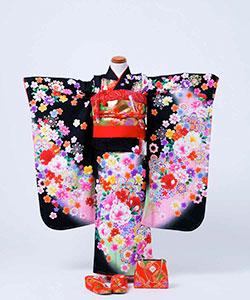 |
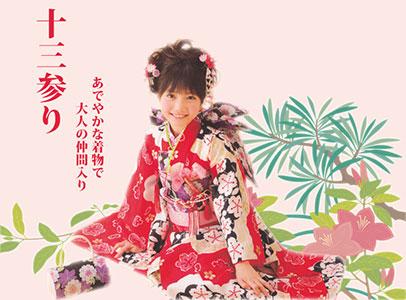 |
| (1) Hifu (被布) is a kind of overcoat you put on top of the kimono. In the Edo period it was worn by tea masters and poets, later women started to wear them also. The 3 years old who visit the shrine wear these jackets. | (2) The shrine visit at 5 years old is only for boys and they wear an Haori as a jacket. | (3) The shrine visit at 7 years does does not wear any jacket | (4) The shrine visit at 13 years (to be awarded wisdom during growing up) is something that has started recently. Also here, no hifu overcoat is being worn. |
[15] Which one is a different kind of color, choose from below answers.
 |
 |
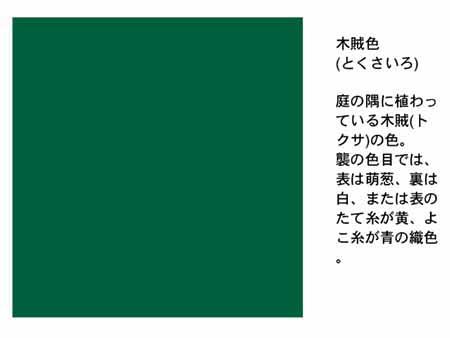 |
 |
| (1) 刈安色 (kariyasu iro) A perennial (infinite time) grass color, mix of green and yellow. |
(2) 黄蘗染色 (kihada senshoku) Creamy yellow dyeing Though the kanji 色 suggests that this is a 'color' but this is not the case, 染色 means dyeing/staining. |
(3) 木賊色 (tokusa iro) Dark green |
(4) 山吹色 (yamabuki iro) Bright golden yellow |
[16] Which textile is finished by weaving without dyeing the thread first, choose from the next answers.
 |
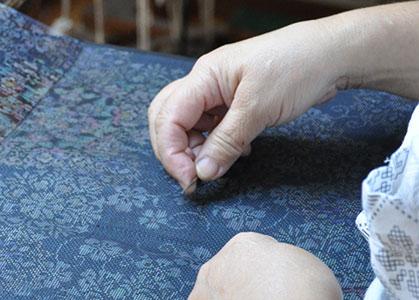 |
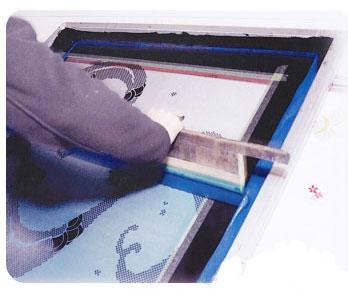 |
 |
| (1) 絣 (Kasuri) Cloth with splashed pattern Fabric that has been woven with fibers dyed specifically to create patterns and images in the fabric. The patterns are characterized by a blurred or brushed appearance. |
(2) 大島紬 (Ooshima tsumugi) Oshima tsumugi weave In the sewing in a plain-weave fabrics dyeing of silk spun by hand in the specialties of Amami Oshima |
(3) 縮緬 (Chirimen) Crepe The cloth is made and the patterns are 'printed' later |
(4) 御召 (Omeshi) (high quality) silk crepe hmmm |
[17] Which is the appropriate obi for the long-sleeved kimono (furisode), choose from the answers below.
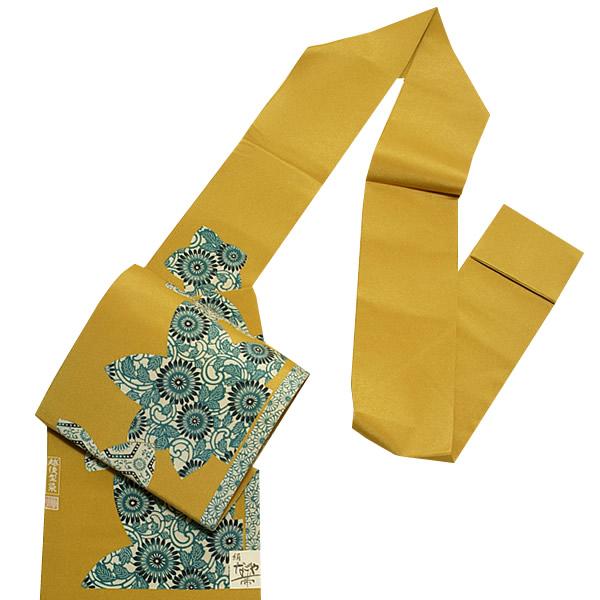 |
 |
 |
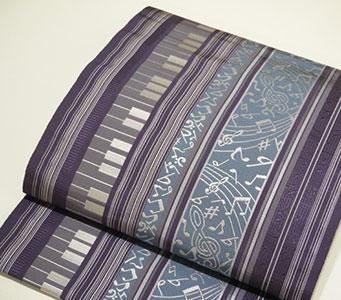 |
| (1) なごや帯 / 名古屋帯 (nagoya obi) is the most-used obi type today. A Nagoya obi is distinguished by its structure: one end is folded and sewn in half, the other end is of full width. This is to make putting the obi on easier. A Nagoya obi can be partly or fully patterned. It is normally worn only in the taiko musubi style, and many Nagoya obi are designed so that they have patterns only in the part that will be most prominent in the knot. A Nagoya obi is shorter than other obi types, about 315 centimetres to 345 centimetres long, but of the same width, about 30 centimetres. |
(2) 袋帯 (fukuro obi) is a grade less formal than a maru obi and the most formal obi actually used today. It has been made by either folding cloth in two or sewing two pieces of cloth together. If two cloths are used, the cloth used for the backside of the obi may be cheaper and the front cloth may be, for example, brocade. Not counting marriage outfits, the fukuro obi has replaced the heavy maru obi as the obi used for ceremonial wear and celebration. A fukuro obi is about 30 centimetres wide and 360 centimetres to 450 centimetres long. When worn, a fukuro obi is almost impossible to tell from a maru obi. |
(3) 半幅帯 (hanhaba obi) is an unlined and informal obi that is used with a yukata or an everyday kimono. Hanhaba obi are very popular these days. For use with yukata, reversible hanhaba obi are popular: they can be folded and twisted in several ways to create colour effects. A hanhaba obi is 15 centimetres wide and 300 centimetres to 400 centimetres long. |
(4) 博多帯 (hakata obi) Stiff obi |
[18] Choose the item which to attach a decorative collar (han-eri) to.
 |
 |
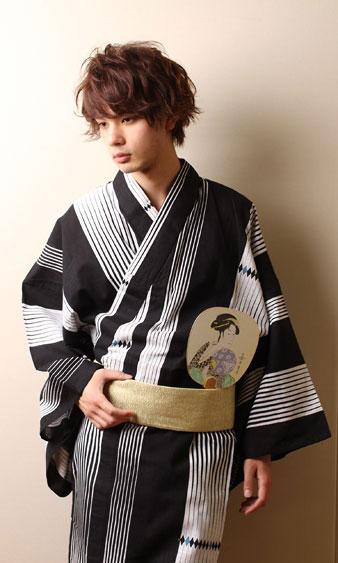 |
 |
| (1) 肌襦袢 (Hadajuban) The first layer of kimono underwear, usually comprising waist length kimono top (hanjuban) like an undershirt, and a susoyoke (wrap underskirt) or a plain V-neck shaped t-shirt and (long) underwear. |
(2) 長襦袢 (Nagajuban) Naga meaning 'long' and juban meaning 'underwear', the Naga-juban is a long undergarment for Kimono. It is worn over the "Hada-juban" and underneath the "Kimono". Only the tip of the Naga-Juban could be seen between your neck and the kimono, but it can create a subtle balance of the entire outfit you are in. You attach an han-eri to this underwear to change the visible part and prevent dirt on the neck part of the juban itself. |
(3) ゆかた (Yukata) Yukata is an unlined dyed cotton kimono for lounging or sleeping in summer. It's worn to enjoy a cool evening breeze or a summer festival in shrines. No eri's are attached to this cloth. |
(4) 小紋のきもの (Komon kimono) On a kimono we attach a different kind of eri namely a date-eri. This is an extra collar layer, stitched onto the inside of a kimono collar, with only its edge showing. A date-eri gives the impression of a naga-juban beneath, allowing the wearer to omit the naga-juban, in order to stay cooler. |
[19] Which is not suitable as a foremost formal dress, choose from the options below.
 |
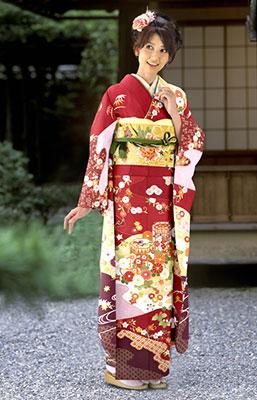 |
 |
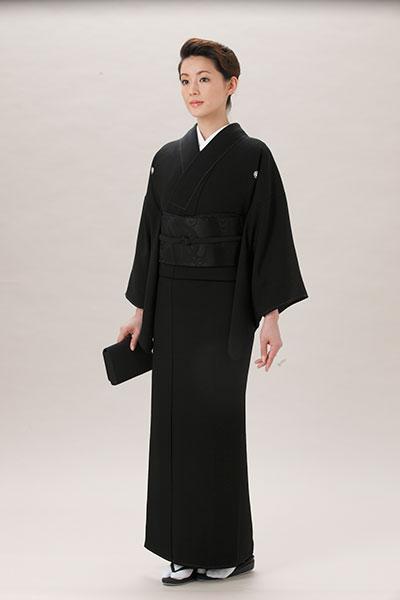 |
| (1) 五つ紋の黒羽二重のきものと仙台平の袴 (itsutsumon no kuro habutai no kimono to sendaihira no hakama) Male formal Wafuku include kimono with the family crest at the five places called Montsuki, black silk kimono called black Habutae, ensemble, and striped flat-weave silk. The most formal dress a man can wear (besides the mouring dress) |
(2) 振袖 (furisode) Long sleeved kimono, a formal dress for celebration worn by young women |
(3) 訪問着 (houmongi) semi-formal kimono for women aka visiting (gala) dress |
(4) 喪服 (mofuku) Mourning dress |
[20] ??? The feature is called kenjo design fabric / The textile of the unusual pattern to be called a presentation pattern ???
 |
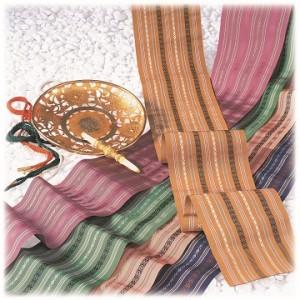 |
 |
 |
| (1) 西陣織 (nishijin ori) Traditional textile from Nishijin , Kyoto. Nishijin weaving is created by using many different types of colored yarns and weaving them together into decorative designs. These specialized procedures are tedious, but necessary to obtain the spectacular design needed to ensure the quality. |
(2) 博多織 (hakata ori) Hakata-ori is characterized by fine, supple, thick material—qualities attained by using a number of thin warps and thick wefts made by twisting multiple thin yarns together. These two layers of yarn are woven together using a reed that creates a horizontal bump in the fabric, and the pattern is woven by bringing the warps to the surface. |
(3) 首里織 (shuri ori) Figured fabric, both silk and cotton, in which warp threads are raised. Two colored threads are used as warp and raised on both sides of fabric, and therefore, they are reversible. Threads, dyed with plant dyes, are woven in “Takahata”(high loom) and finished with unique fulling, produced in Shuriteramacha Naha city, Okinawa |
(4) ミンサー織 (minsaa ori) Traditional textile of the Yaegama Island in Okinawa |
[21] In which era was the Meisen Silk dye pattern created.
 |
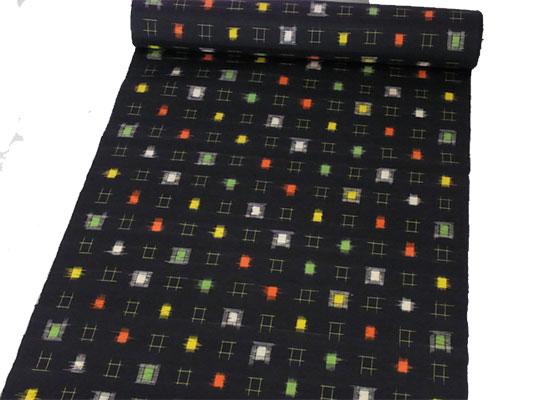 |
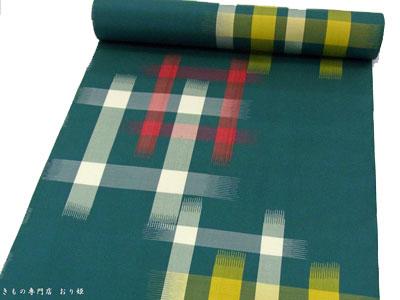 |
 |
| (1) 明治時代 (Meiji era) 1868-1912 (image = meisen) |
(2) 大正時代 (Taisho era) 1912-1926 (image = meisen) |
(3) 江戸時代 (Edo era) 1603-1868 (image = meisen) |
(4) 昭和時代 (Showa era) 1926-1989 (image = meisen) |
[22] Which of the following does not belong in this list of patterns.
 |
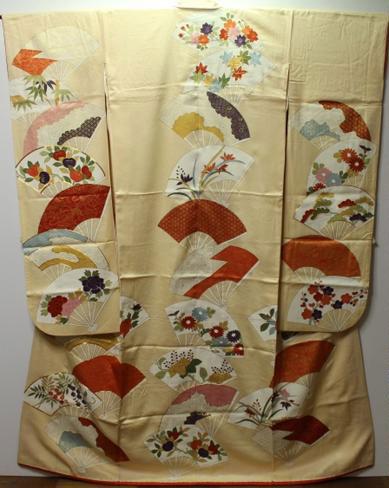 |
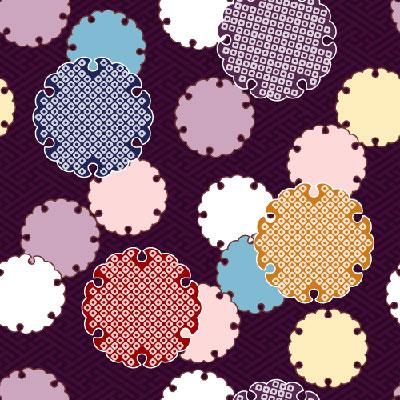 |
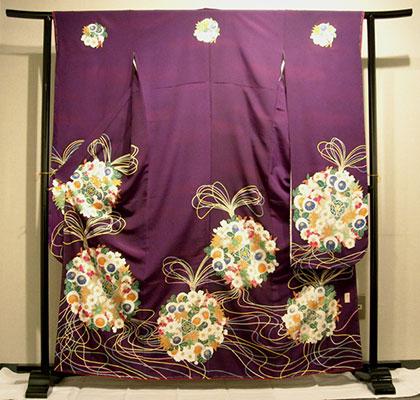 |
| (1) 貝桶 (kaioke) a bucket for clamshells |
(2) 扇面 (senmen) Paper fan |
(3) 雪輪 (yukiwa) Snowflake shape Probably because the rest are festive items or man made items? |
(4) 薬玉 (kusudama) Decorative paper ball (for festive occasions) |
[23] Choose from the following choices the incorrect way to put away a kimono
 |
 |
 |
 |
| (1) Store silk and wool items separately | (2) Insect repellent Camphor and Naphthalin used together has a powerfull effect for kimono safekeeping | (3) Confidentiality avoid the tall plastic storage box | (4) After using the kimono, dry in the shade and let the moisture fly away |
[24] Choose which kimono can be used for a ceremony and semi-mourning.
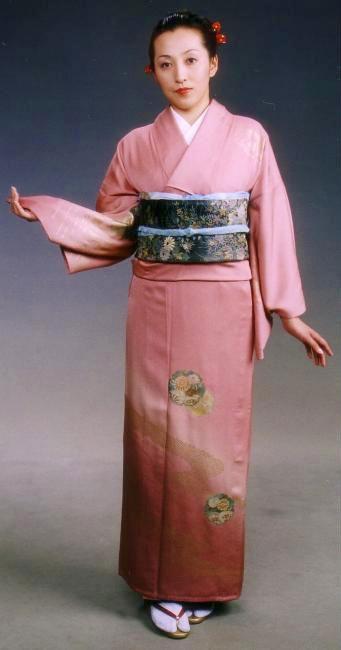 |
 |
 |
 |
| (1) 付け下げ (tsukesage) A kimono where the pattern seems to be rising from the hem to the shoulder. And the bottom of the sleeve to the top of the sleeve. |
(2) 小紋 (komon) Kimono with the same pattern repeated, called edo-komon if the patterns are so small that from a distance you see a solid color. Stencil dyed or woodblock printed. |
(3) 色無地 (iromuji) A single colored kimono without a pattern. Together with a dark obi it can be used for a buddhist memortial service and semi-mourning occasions. |
(4) 紬 (tsumugi) Pongee (soft thin cloth woven from raw silk) |
[25] Choose from the next answers which dyeing and weaving product is not made in Niigata.
 |
 |
 |
 |
| (1) 越後上布 (echigo joufu) Echigo is the old name for Niigata Prefecture, High quality plain woven hemp cloth. |
(2) 塩沢紬 (shiozawa tsumugi) A hand woven pongee made in Shiozawa which lies in Niigata Prefecture |
(3) 十日町紬 (tokamachi tsumugi) This hand woven pongee is made in Tokamachi which lies in Niigata Prefecture |
(4) 宮古上布 (miyako joufu) High quality hemp cloth from Miyakojima (Okinawa Prefecture) |
